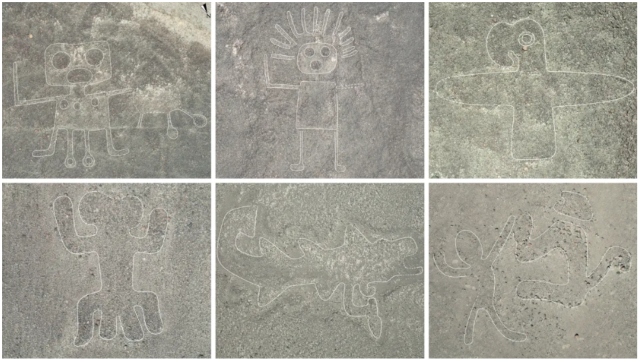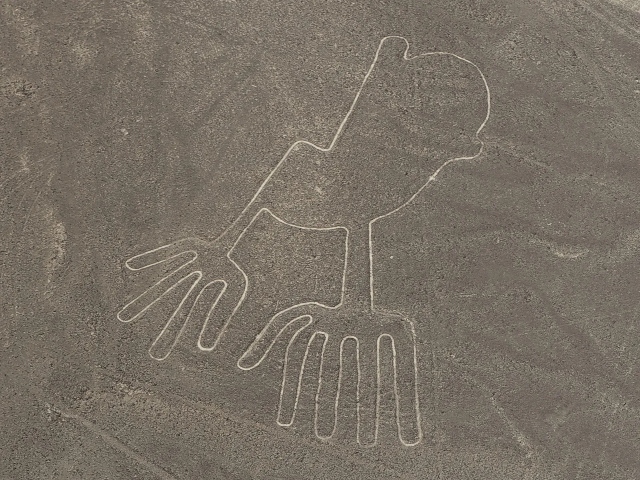[imagesource: Britannica]
For all the paranoia around AI and the impending Terminator apocalypse, there has been some really cool stuff coming out of our courtship with intelligent machines.
AI’s latest gift to humanity is the surprising discovery of hundreds of previously undiscovered ancient symbols in Peru’s Nazca region.
Assisted by artificial intelligence, archaeologists have discovered 303 unknown giant symbols including birds, plants, spiders, humanlike figures with headdresses, decapitated heads and an orca wielding a knife.
Described in a study published Monday in the journal PNAS, the discovery almost doubles the number of known Nazca geoglyphs, mysterious artworks formed in the ground by moving stones or gravel that date back some 2,000 years. The researchers’ findings also shed some light on the symbols’ enigmatic purpose.
Located 50 kilometres inland from Peru’s south coast, the huge symbols were found in the desert beginning in the early 20th century. Some 500 metres above sea level, the geoglyphs have survived the ages because the dry desert region is sparsely populated, not affected by flooding and unsuitable for growing crops.
According to the research, the rate of new discoveries has grown recently as a result of the usage of distant high-resolution photography; from 2000 to 2020, an average of 19 geoglyphs were identified per year. However, according to the study, the application of AI to screen possible candidates has significantly accelerated the process, promising “a revolution in archaeological findings.
The most recent geoglyph discovery was made by a team of academics under the direction of Masato Sakai, an archaeology professor at Yamagata University in Japan. The researchers used high-resolution images of the 430 Nazca symbols that have been mapped as of 2020 to train an object identification AI model.
The team chose to focus on the smaller and more figurative of the two types of symbols discovered in the desert. Figurative geoglyphs are typically around 9 metres in length and have been more difficult to identify than the larger line type, which is 90 metres in length and thus has been more easily spotted during aerial surveys.

The AI model was by no means perfect. It suggested more than 47,000 potential sites from the desert region, which covers 629 square kilometres. The team screened and ranked those suggestions, identifying 1,309 candidate sites with “high potential.”For every 36 suggestions made by the AI model, the researchers identified “one promising candidate”.The team surveyed the prospective areas in the Nazca Desert between September 2022 and February 2023 using drones and foot surveys, and found that “the geoglyphs in good condition were immediately recognised for what they were.”
Out of the 303 recently found figurative geoglyphs, 125 were additional findings and 178 were indicated by the model. Of those, 66 were determined to be a part of a geoglyph cluster that AI had located, while the remaining 59 were uncovered when doing fieldwork independently of AI assistance.
Undiscovered geoglyphs might number in the thousands.
According to Amina Jambajantsan, a researcher and data scientist at the Max Planck Institute of Geoanthropology’s Department of Archaeology, AI has the potential to make huge contributions to archaeology, although the models are not yet perfectly accurate.
“The problem is archaeologists don’t know how to build a machine learning model and data scientists, typically, are not really interested in archaeology because they can get much more money elsewhere.”
It’s not clear why the Nazca people made the symbols. The main hypothesis is that they formed a ‘sacred space’ that was perhaps a place of pilgrimage. Other theories propose they played a part in calendars, astronomy, irrigation or movement, such as running or dancing, or communication.
The larger, line-type geoglyphs easily visible from above typically depict wildlife such as animals or plants, while the smaller geoglyphs include humans or things involving humans such as human sacrifice or domesticated llamas.
[source:cnn]





